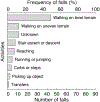Frequency and Circumstances of Falls Reported by Ambulatory Unilateral Lower Limb Prosthesis Users: A Secondary Analysis
- PMID: 30195705
- PMCID: PMC6405319
- DOI: 10.1016/j.pmrj.2018.08.385
Frequency and Circumstances of Falls Reported by Ambulatory Unilateral Lower Limb Prosthesis Users: A Secondary Analysis
Abstract
Background: More than 50% of lower limb prosthesis (LLP) users report falling at least once a year, placing them at high risk for adverse health outcomes such as decreased mobility and diminished quality of life. Efforts to decrease falls in LLP users have traditionally focused on developing clinical tests to assess fall risk, designing prosthetic components to improve patient safety, and identifying risk factors to recognize potential fallers. Little attention has been directed toward recording, reporting, and characterizing the circumstances of falls in LLP users. Identifying the most common types of falls could help guide and prioritize clinical and research needs.
Objective: To characterize the frequency and circumstances of falls reported by unilateral LLP users.
Design: Secondary analysis of data from 2 cross-sectional studies.
Setting: Outpatient clinic and research laboratory.
Participants: Ambulatory unilateral transtibial and transfemoral LLP users (N = 66).
Intervention: None.
Outcome: A fall-type classification framework was developed based on biomechanical theory and published falls terminology. Self-reported falls and accompanying narrative descriptions of LLP users' falls in the previous 12 months were analyzed with the framework. Frequencies, estimated proportions, and estimated counts were compared across fall circumstances using 95% confidence intervals.
Results: Thirty-eight participants (57.6%) reported 90 falls during the previous year. All reported falls were successfully categorized using the proposed framework. Most falls occurred from disruptions to the base of support, intrinsic destabilizing factors, and a diverse set of fall patterns. Walking on level terrain was the most common activity at the time of a fall.
Conclusion: This secondary analysis showed that falls remain frequent in ambulatory LLP users and that clinicians and researchers might wish to prioritize falls owing to disruptions of the base of support that occur while walking. Additional research with a larger sample is required to confirm and expand these results.
Level of evidence: III.
© 2018 American Academy of Physical Medicine and Rehabilitation.
Figures



References
-
- Kulkarni J, Wright S, Toole C, Morris J, Hirons R. Falls in patients with lower limb amputations: prevalence and contributing factors. Physiotherapy. 1996;82:130–6.
-
- Gauthier-Gagnon C, Grisé MC, Potvin D. Enabling factors related to prosthetic use by people with transtibial and transfemoral amputation. Arch of Phys Med Rehabil. 1999;80:706–13. - PubMed
-
- Miller WC, Speechley M, Deathe B. The prevalence and risk factors of falling and fear of falling among lower extremity amputees. Arch of Phys Med Rehabil. 2001;82:1031–7. - PubMed
-
- Ülger Ö, Topuz S, Bayramlar K, Erbahçeci F, Sener G. Risk factors, frequency, and causes of falling in geriatric persons who has had a limb removed by amputation. Top Geriatr Rehabil. 2010;26:156–63.
-
- Wong CK, Chen CC, Blackwell WM, Rahal RT, Benoy SA. Balance ability measured with the Berg balance scale: a determinant of fall history in community-dwelling adults with leg amputation. J Rehabil Med. 2015;47:80–6. - PubMed
Publication types
MeSH terms
Grants and funding
LinkOut - more resources
Full Text Sources
Other Literature Sources
Medical
Research Materials

